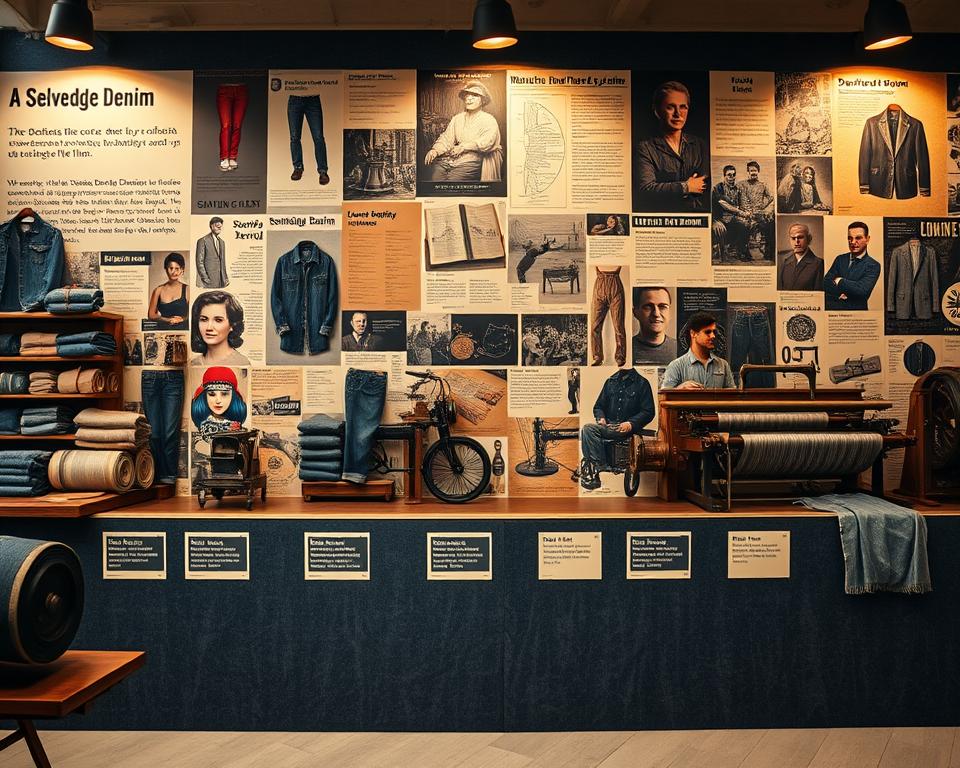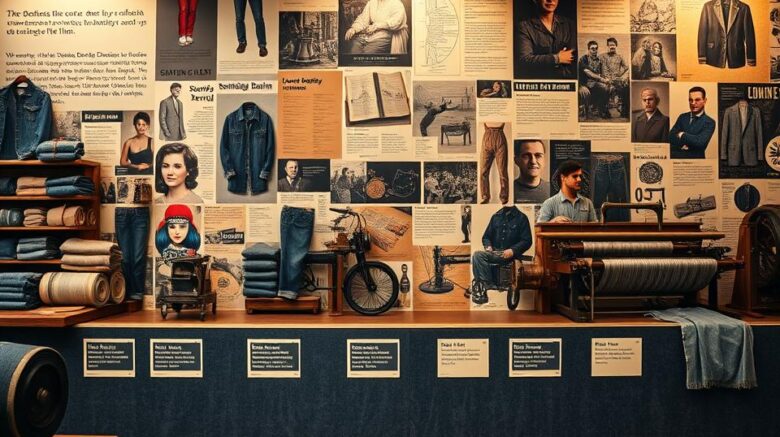A Comprehensive Guide for High-Quality denim Selvedge Material
Ever questioned the reason certain trousers seem like they’re made to last the ages? Everything revolves around the elements and skill. For example, the increasing movement of high-end selvedge. This goes beyond common material—it’s a testament to quality and heritage.
Nowadays, a growing number of people are turning to these classic materials for their sturdiness and iconic selvedge denim by the yard charm. Whether you’re a DIY sewist or a denim enthusiast, there’s a unique quality about using superior natural fiber and thread. It goes beyond merely constructing trousers; it’s about fashioning something that tells a story.
Within Core Fabrics, we’ve selected a selection of 14.25oz certified organic cotton and elastic options. Such textiles are ideal for everything from raw trousers to designer jacket designs. Prepared to dive into the universe of premium fabrics? Let’s dive in.
What Is Denim Selvedge Fabric?
What makes some trousers distinguish themselves with their unique, self-finished seams? The key lies in the selvedge denim, a high-quality fabric celebrated for its durability and vintage appeal. In contrast to conventional textiles, such material is produced using classic methods that have stood the test of time.
Understanding Selvedge Denim
Selvedge denim is manufactured with vintage shuttle looms, which produce minimal widths of about 30-35 inches. They intertwine the material in a method that delivers self-finished edges, often marked by a signature red line. This method confirms the fabric is firmly crafted and extremely robust.
Contemporary looms, alternatively, generate expansive material but fall short of the comparable degree of skill. Minor flaws in selvedge, like leg twists or irregular surfaces, are accepted as features of its character. This philosophy, termed “wabi-sabi”, exalts the appeal of inherent flaws.
Production of Selvedge Denim
The production of selvedge denim entails a detailed process. Shuttle looms cross the weft thread alternately, forming a thick and sturdy textile. This method contrasts with contemporary machines, which emphasize rapid output over craftsmanship.
Brands like Karson Denim uphold traditional Japanese methods from the 90s. They purposefully add anomalies to preserve the true character of the textile. All products is graded on a 4-point system, ensuring it meets the peak requirements of quality.
| Attribute | Selvedge Denim | Contemporary Denim |
|---|---|---|
| Measure | 30-35 inches | 60+ inches |
| Weaving Process | Shuttle Loom | Contemporary Loom |
| Finish | Non-uniform, Raw | Consistent |
| Strength | Exceptional | Moderate |
“The beauty of selvedge lies in its imperfections—each flaw tells a story craftsmanship and tradition.”
The History of Selvedge Denim
Starting from modest origins to global acclaim, the story of these materials is vibrant and motivational. Originally developed as durable workwear in 17th-century France has become a mark of everlasting fashion and artistry.
Beginnings in Craftsmanship
The foundation of this material trace back to Nîmes, France, where it was known as “serge de Nîmes.” Initially created for the working class, it was constructed with hardwearing cotton and thread. Its strength rendered it beloved among laborers during the historic Gold Rush.
In the 20th century, it had evolved into a staple for pants. The shuttering of the Cone Mills White Oak plant marked a turning point. This change enabled Japanese artisans to restore old-world weaving methods.

Modern Developments in Denim
Post-WWII, Japan embraced old-school American culture. Artisans restored classic looms to manufacture genuine reproductions. This devotion to artistry secured the perseverance of selvedge as a niche product.
Today, advancements from Italy and Turkey have launched eco-friendly combinations and elastic selections. These modernizations have expanded the attraction of this everlasting fabric. Within Core Fabrics, we procure internationally, from Montréal to Asia, to offer you the top-notch standards.
“Selvedge’s story is a testament to the perennial merit of quality and tradition.”
Why Choose Selvedge Denim?
What makes selvedge denim distinguish itself in the world of top-tier fabrics? Its unique qualities and unmatched durability make it a favorite among aficionados and stylists alike. Be it that you are making pants or a tailored jacket, this fabric provides a mix of tradition and contemporary charm.
Distinctive Attributes of Selvedge
Selvedge denim is renowned for its tight weave, which enhances ripping resistance and color fading characteristics. In contrast to common fabrics, selvedge denim material is produced using traditional shuttle looms, creating a more compact and extra robust fabric. Such a process guarantees that every item possesses a distinct surface and personality.
Here’s what makes it special:
- Hairy, rigid raw denim contrasts with pre-washed comfort stretches.
- Through sanforization, sizes become reliable, while natural variants entail a shrink-to-fit adventure.
- Available weights span from 9.5oz Eco Finish to 14.25oz Organic, suited for different needs.
Robustness and Endurance
One of the standout features of selvedge denim is its enduring nature. The firm interlacing not only increases durability but also allows for unique fading patterns over time. This renders it a wise purchase for those in pursuit of enduring style.
Important aspects:
- Fabrics weighing between 12oz and 14oz are perfect for form-fitting jackets and jeans that mellow with time.
- Opt for the 14.25oz True Indigo for traditional jean lifespan.
- Eco-friendly options, like recycled cotton and indigo blends, add sustainability to your wardrobe.
At Core Fabrics, our collection includes a variety of options to suit your needs. Spanning from raw finishes to sanforized treatments, each selection is designed for superior quality and value.
Selvedge Denim vs. Wide Denim
When it comes to crafting long-lasting and trendy pieces, the choice of fabric matters significantly. Among the prevalent selections are selvedge and wide denim, each possessing distinct traits. Knowing how they differ assists in selecting the ideal material for your endeavor.
Key Differences in Weaving Techniques
Selvedge denim is produced using time-honored shuttle looms, yielding narrow widths of 30-35 inches. This striped selvedge denim fabric method forms firm borders, often marked by a signature red line. Conversely, wide denim employs advanced projectile looms, resulting in widths of 60 inches or more.
Old-style shuttle looms yield roughly 3m per minute, while modern projectile looms reach speeds of 30 meters per minute. Such speed differences influence both the expense and the texture of the final product.
Advantages and Disadvantages
Selvedge denim is celebrated for its superior quality and strength. Its narrow width suits it well for projects where defined edges and detail work are sought. However, it can be pricier, typically around $23 per meter.
Wide denim is economical, priced around $8 per half-meter. Its wider width reduces waste, making it suitable for big-scale works like furniture covering. However, it does not feature the unique edge finish of selvedge.
| Characteristic | Selvedge Denim | Wide Denim |
|---|---|---|
| Span | 30-35 inches | 60+ inches |
| Method | Classic Shuttle Loom | Modern Projectile |
| Production Speed | 3m/min | 30m per minute |
| Price | $23/meter | $8 per half-meter |
For structured edges, like those needed in Grainline Thayer jackets, selvedge is the preferred choice. Conversely, wide denim is ideal for extensive projects due to its efficiency. Evaluate your project specifications to choose wisely.
Maximizing Your Selvedge Denim
Crafting with high-end textiles raises your projects to a new standard. Whether you are creating jeans, jackets, or frocks, knowing how to measure, sew, and care for the material secures expert outcomes. Let’s delve into the optimal use of this timeless textile.
Fabric Quantities for Your Projects
Determining the proper yardage is key to a successful project. For men’s jeans, you’ll need about 3-3.3 yards, accounting for potential defects and shrinkage. For trucker jackets, expect to use around 3.3 yards, while a skirt often needs 2 yards.
Innovative layout techniques can mitigate fabric flaws. Rather than avoiding imperfections, incorporate them into your pattern for distinctive style.
| Garment | Required Yardage |
|---|---|
| Male Jeans | 3–3.3 yards |
| Trucker Jacket | 3.3 yards |
| Dress | 2 yards |
Sewing Techniques and Maintenance
The correct gear and skills secure a refined outcome. Opt for #70–110 needles and foot accessories suitable for thick fabrics. For contrast stitching, Gütermann rPET thread is a reliable choice.
Consider these extra tips:
- A tailor’s clapper helps deliver defined creases without unwanted shine.
- Core Fabrics provides denim kits with topstitch thread, rivets, and 9mm buttons for that expert touch.
- When sturdy borders are needed, such as in jackets, selvedge is optimal.
Maintaining your pieces properly increases their longevity. Use minimal washing and opt for air drying to preserve fabric quality. Adhering to these practices will sustain your creations for years.
Final Remarks
Crafting with premium materials isn’t just about durability—it’s about creating something with character. Selvedge denim exemplifies this ideology, blending artisanal charm with long-lasting quality. Be it crafting jeans or tailoring a refined jacket, each stitch narrates a tale.
At Core Fabrics, we make it easy to explore your creativity. Try our swatch service to feel the texture and weight before committing. Plus, enjoy free shipping on orders over $150 USD across North America.
Looking ahead, eco-friendly blends and vintage washes are shaping the future of cotton textiles. Such innovations provide novel methods for infusing eco-consciousness and fashion into your closet.
Ready to dive into the world of premium materials? Shop now and discover the value of crafting with purpose. Your future project might just be that lasting masterpiece.
